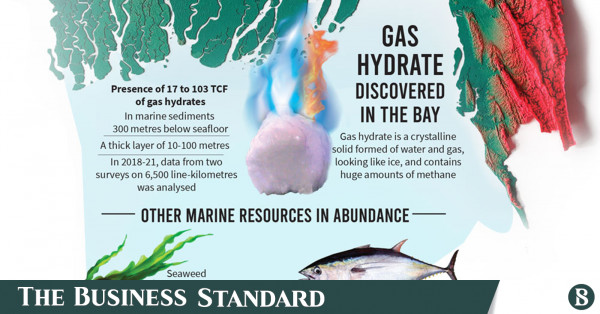Bangladesh has found around 17 to 103 trillion cubic feet (TCF) of gas hydrates in the Bay of Bengal.
The Maritime Affairs Unit of the foreign ministry found the existence of gas hydrates in a survey conducted in association with the Netherlands and the UK.
"We have not been able to survey the whole area yet. But, as far as we are concerned, we estimate that there is about 17 to 103 TCF gas hydrates," Khurshed Alam, the head of the research unit, made the disclosure at a press conference at the ministry on Wednesday.
Besides, there is huge potential of commercial production and processing of seaweed in the Bay of Bengal, said the research team head.
According to the NOAA Ocean Exploration, the only US federal organisation dedicated to exploring the deep ocean, gas hydrates are ice-like crystalline minerals that form when low molecular weight gas (such as methane, ethane, or carbon dioxide) combines with water and freezes into a solid under low temperature and moderate pressure conditions.
Most gas hydrates are formed from methane (CH4), which has led to the terms "gas hydrate" and "methane hydrate" often being used interchangeably.
Gas hydrates occur naturally in some marine sediments and within and beneath permafrost.
Hydrate deposits are important for a variety of reasons. Gas hydrate deposits may contain roughly twice the carbon contained in all reserves of coal, oil, and conventional natural gas combined, making them a potentially valuable energy resource.
Gas hydrates in the ocean can be associated with unusual and possibly unique biological communities that use hydrocarbons or hydrogen sulfide for carbon and energy, via a process known as chemosynthesis.
Plethora of marine lifeforms discovered
The Maritime Affairs Unit also conducted joint field-level research in the sea area of Bangladesh in 2020. The study analysed the economic potential in Bangladesh's exclusive economic zone (EEZ), including the identification of various species.
On the basis of the mapping results, 220 species of seaweed, 347 species of marine fish, 498 species of oysters, 52 species of shrimps, five species of lobsters, six species of crabs and 65 species of sea-grass were identified in the country.
Necessary laboratory tests on these species were later performed in the Netherlands.
According to the report issued at the press briefing, the discovery of such diverse marine flora and fauna will contribute exponentially to the blue economy of Bangladesh.
The statement from the Foreign Ministry also outlined five industrial applications of certain species of seaweed including:
- Fish feed: Some species of seaweed found in Bangladesh contain a lot of protein which can be used as a source of fish feed protein and can be an alternative to imported fish oil.
- Animal feed: Some species of seaweed found in Bangladesh are rich in fatty acids which contribute to increasing the quality of animal feed and the immunity of animals.
- Food additive: Seaweeds found in Bangladesh contain Agar-Agar that is extensively used in the food industry. In addition, seaweed can be eaten directly or processed.
- Bulk cosmetics ingredient: Species of seaweeds found in Bangladesh has a lot of gelling agents which are currently being used in the cosmetics industry.
- High value cosmetics ingredient: Seaweed in Bangladesh has a lot of high-value ingredients that can be used to make a variety of cosmetics products.

Big potential in Bay as 17-103 TCF gas hydrates found
The discovery of gas hydrates has come as a blessing


